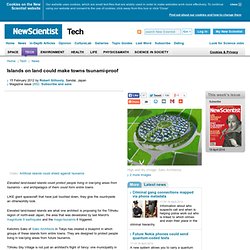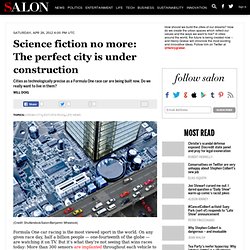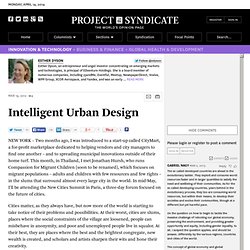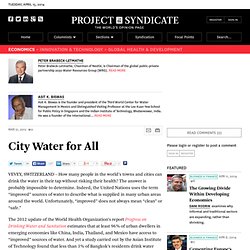

Cities As Gardens. But by 2005, we've passed a milestone in our history, in that 50 percent of humanity, 50 percent of all human beings, lived in cities by 2005.

And the projection is that by 2050, three out of every four of us will live in cities around the world. And so images like this will become the norm, rather than the visions of Arcadia. And already we can make a plot of cities around the world of more than a million inhabitants. And that figure's only going to get larger and larger.
And already the world at night reflects this movement to urbanization. Islands on land could make towns tsunami-proof - tech - 15 February 2012. Video: Artificial islands could shield against tsunamis Elevated land-based islands could protect people living in low-lying areas from tsunamis – and archipelagos of them could form entire towns LIKE giant spacecraft that have just touched down, they give the countryside an otherworldly look.

Elevated land-based islands are what one architect is proposing for the Tōhoku region of north-east Japan, the area that was devastated by last March's magnitude 9 earthquake and the mega-tsunamis it triggered. Science fiction no more: The perfect city is under construction. Formula One car racing is the most viewed sport in the world.

On any given race day, half a billion people — one-fourteenth of the globe — are watching it on TV. But it’s what they’re not seeing that wins races today: More than 300 sensors are implanted throughout each vehicle to monitor everything from air displacement to tire temperature to the driver’s heart rate. These data are continuously transmitted back to a control room, where engineers run millions of calculations in real time and tweak their driver’s strategy accordingly. "Self and the City" by Avner de-Shalit. Exit from comment view mode.

Click to hide this space BEIJING – What is the big story of our age? It depends on the day, but if we count by centuries, then surely humanity’s urbanization is a strong contender. A plea for beauty: a manifesto for a new urbanism - Society and Culture. AEI’s new Society and Culture Outlook will examine important ideas in areas such as architecture, art, literature, music, and philosophy that are outside today’s front-page news.

Subscribe to this series A plea for beauty: a manifesto for a new urbanism Download PDF Our culture is a culture of cities, and without cities we could not conceivably have enjoyed the enormous scientific, economic, and political advances of the Enlightenment. Cities are also the heart of the modern nation state, and every country that modernizes does so by mass migration from country to city. "Intelligent Urban Design" by Esther Dyson. Exit from comment view mode.

Click to hide this space NEW YORK – Two months ago, I was introduced to a start-up called CityMart, a for-profit marketplace dedicated to helping vendors and city managers to find one another – and to spreading municipal innovations outside of their home turf. "City Water for All" by Peter Brabeck-Letmathe. Exit from comment view mode.

Click to hide this space VEVEY, SWITZERLAND – How many people in the world’s towns and cities can drink the water in their tap without risking their health? The answer is probably impossible to determine. Indeed, the United Nations uses the term “improved” sources of water to describe what is supplied in many urban areas around the world.
Unfortunately, “improved” does not always mean “clean” or “safe.” The 2012 update of the World Health Organization’s report Progress on Drinking Water and Sanitation estimates that at least 96% of urban dwellers in emerging economies like China, India, Thailand, and Mexico have access to “improved” sources of water. Visit any major city in an emerging economy, from Mexico City to Mumbai, and you will be hard pressed to find anyone who believes that the water piped into their homes is fit to drink. It doesn’t have to be like this. With a low-key but firm management style, Chan began to turn things around. Burying Bits of the City: Hong Kong Underground. Several months ago we looked at a network of artificial caves being built beneath Singapore that will, upon completion, extend the city's energy infrastructure under the Pacific seabed; and, back in 2010, we took a very brief look at huge excavations underneath Chicago, courtesy of a feature article in Tunnel Business Magazine.

Now, according to the South China Morning Post, civil engineers in Hong Kong are exploring the possibility of developing large-scale underground spaces—artificial caves—for incorporation into the city's existing infrastructure. In the full text of the article, available online courtesy of Karst Worlds, we read that the Hong Kong government "is moving towards burying bits of the city—the unsightly ones—in underground caverns, freeing up more land for housing and economic development. " [Image: From the Enhanced Use of Underground Space in Hong Kong]. [Image: From the Enhanced Use of Underground Space in Hong Kong; view bigger].